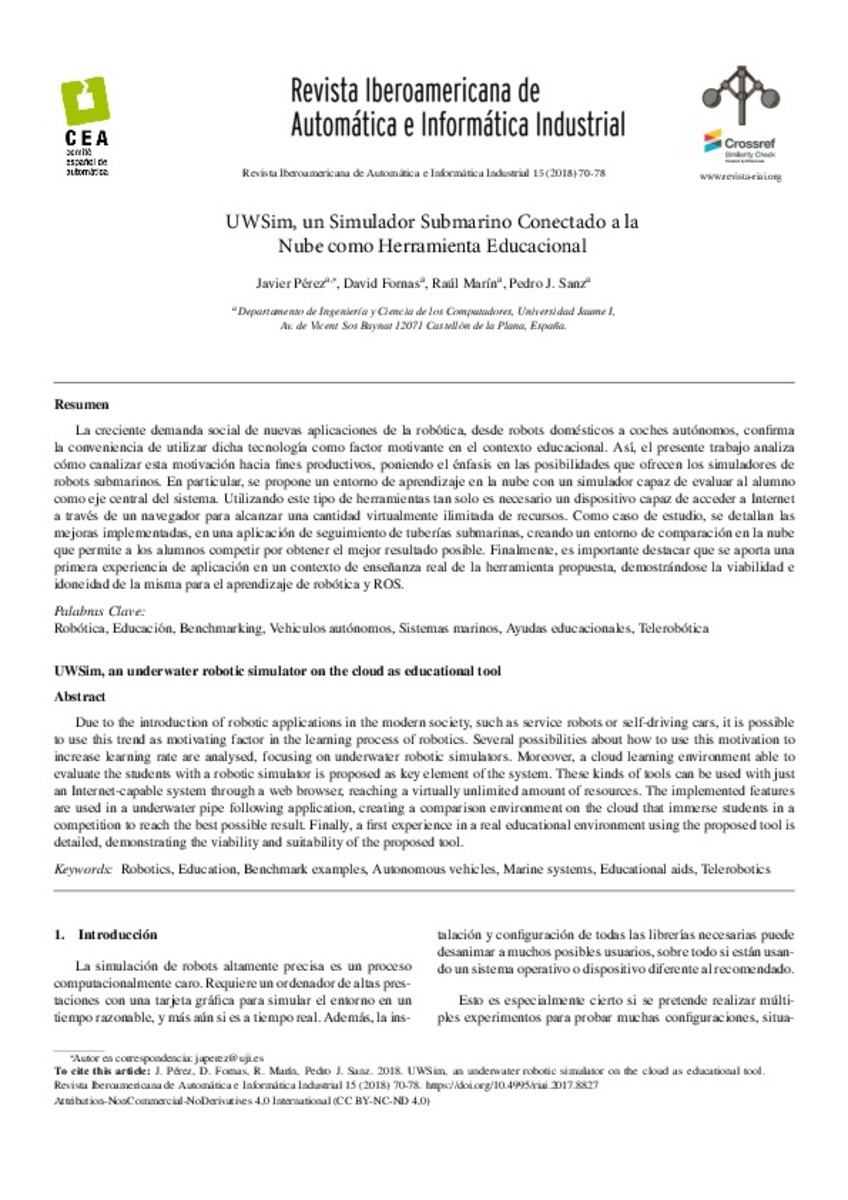Mostrar el registro sencillo del ítem
UWSim, un simulador submarino conectado a la nube como herramienta educacional
| dc.contributor.author | Pérez Soler, Javier | |
| dc.contributor.author | Fornas Garcia, David | |
| dc.contributor.author | Marin, Raul | |
| dc.contributor.author | Sanz, Pedro J | |
| dc.date.accessioned | 2019-05-06T18:42:25Z | |
| dc.date.available | 2019-05-06T18:42:25Z | |
| dc.date.issued | 2018 | |
| dc.identifier.citation | Pérez, Javier, et al. "UWSim, an underwater robotic simulator on the cloud as educational tool." Revista Iberoamericana de Automática e Informática Industrial, 2018, vol. 15, núm. 1, p. 70-78 | ca_CA |
| dc.identifier.issn | 1697-7920 | |
| dc.identifier.issn | 1697-7912 | |
| dc.identifier.uri | http://hdl.handle.net/10234/182413 | |
| dc.description.abstract | La creciente demanda social de nuevas aplicaciones de la rob´otica, desde robots dom´esticos a coches aut´onomos, confirma la conveniencia de utilizar dicha tecnolog´ıa como factor motivante en el contexto educacional. As´ı, el presente trabajo analiza c´omo canalizar esta motivaci´on hacia fines productivos, poniendo el ´enfasis en las posibilidades que ofrecen los simuladores de robots submarinos. En particular, se propone un entorno de aprendizaje en la nube con un simulador capaz de evaluar al alumno como eje central del sistema. Utilizando este tipo de herramientas tan solo es necesario un dispositivo capaz de acceder a Internet a trav´es de un navegador para alcanzar una cantidad virtualmente ilimitada de recursos. Como caso de estudio, se detallan las mejoras implementadas, en una aplicaci´on de seguimiento de tuber´ıas submarinas, creando un entorno de comparaci´on en la nube que permite a los alumnos competir por obtener el mejor resultado posible. Finalmente, es importante destacar que se aporta una primera experiencia de aplicaci´on en un contexto de ense˜nanza real de la herramienta propuesta, demostr´andose la viabilidad e idoneidad de la misma para el aprendizaje de rob´otica y ROS. | ca_CA |
| dc.description.abstract | Due to the introduction of robotic applications in the modern society, such as service robots or self-driving cars, it is possible to use this trend as motivating factor in the learning process of robotics. Several possibilities about how to use this motivation to increase learning rate are analysed, focusing on underwater robotic simulators. Moreover, a cloud learning environment able to evaluate the students with a robotic simulator is proposed as key element of the system. These kinds of tools can be used with just an Internet-capable system through a web browser, reaching a virtually unlimited amount of resources. The implemented features are used in a underwater pipe following application, creating a comparison environment on the cloud that immerse students in a competition to reach the best possible result. Finally, a first experience in a real educational environment using the proposed tool is detailed, demonstrating the viability and suitability of the proposed tool | ca_CA |
| dc.description.abstract | Due to the introduction of robotic applications in the modern society, such as service robots or self-driving cars, it is possible to use this trend as motivating factor in the learning process of robotics. Several possibilities about how to use this motivation to increase learning rate are analysed, focusing on underwater robotic simulators. Moreover, a cloud learning environment able to evaluate the students with a robotic simulator is proposed as key element of the system. These kinds of tools can be used with just an Internet-capable system through a web browser, reaching a virtually unlimited amount of resources. The implemented features are used in a underwater pipe following application, creating a comparison environment on the cloud that immerse students in a competition to reach the best possible result. Finally, a first experience in a real educational environment using the proposed tool is detailed, demonstrating the viability and suitability of the proposed tool. | ca_CA |
| dc.format.extent | 9 p. | ca_CA |
| dc.format.mimetype | application/pdf | ca_CA |
| dc.language.iso | spa | ca_CA |
| dc.publisher | Universitat Politècnica de València | ca_CA |
| dc.publisher | Comité Español de Autonomática (CEA-IFAC) | ca_CA |
| dc.relation.isPartOf | Revista Iberoamericana de Automática e Informática Industrial, 2018, vol. 15, núm. 1, p. 70-78 | ca_CA |
| dc.rights | Esta revista se publica bajo una Licencia Creative Commons Atribución-NoComercial-SinDerivar 4.0 Internacional | ca_CA |
| dc.rights | Attribution-NonCommercial-NoDerivatives 4.0 Internacional | * |
| dc.rights.uri | http://creativecommons.org/licenses/by-nc-nd/4.0/ | * |
| dc.subject | robótica | ca_CA |
| dc.subject | educación | ca_CA |
| dc.subject | benchmarking | ca_CA |
| dc.subject | vehículos autónomos | ca_CA |
| dc.subject | sistemas marinos | ca_CA |
| dc.subject | ayudas educacionales | ca_CA |
| dc.subject | telerobótica | ca_CA |
| dc.subject | robotics | ca_CA |
| dc.subject | education | ca_CA |
| dc.subject | benchmark examples | ca_CA |
| dc.subject | autonomous vehicles | ca_CA |
| dc.subject | marine systems | ca_CA |
| dc.subject | educational aids | ca_CA |
| dc.subject | telerobotics | ca_CA |
| dc.title | UWSim, un simulador submarino conectado a la nube como herramienta educacional | ca_CA |
| dc.title.alternative | UWSim, an underwater robotic simulator on the cloud as educational tool | ca_CA |
| dc.type | info:eu-repo/semantics/article | ca_CA |
| dc.identifier.doi | https://doi.org/10.4995/riai.2017.8827 | |
| dc.relation.projectID | Este trabajo ha sido parcialmente financiado por el Ministerio de Econom´ıa y competitividad, c´odigo de proyecto DPI2014-57746-C3 (proyecto MERBOTS), por la Generalitat Valenciana GVA, con el c´odigo de proyecto PROMETEO /2016/066 y por la Universidad Jaume I,proyecto MASUMIA, becas PREDOC/2012/47 y PREDOC/2013/46. | ca_CA |
| dc.rights.accessRights | info:eu-repo/semantics/openAccess | ca_CA |
| dc.relation.publisherVersion | https://polipapers.upv.es/index.php/RIAI/article/view/8827 | ca_CA |
| dc.type.version | info:eu-repo/semantics/publishedVersion | ca_CA |
Ficheros en el ítem
Este ítem aparece en la(s) siguiente(s) colección(ones)
-
ICC_Articles [419]








